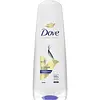What's inside
What's inside
 Key Ingredients
Key Ingredients

 Benefits
Benefits

 Concerns
Concerns

 Ingredients Side-by-side
Ingredients Side-by-side

Aloe Barbadensis Leaf Juice
Skin ConditioningBehentrimonium Methosulfate
Cetearyl Alcohol
EmollientCarthamus Tinctorius Seed Oil
MaskingGlycerin
HumectantStearamidopropyl Dimethylamine
EmulsifyingPropanediol
SolventPanthenol
Skin ConditioningPolyquaternium-10
Nigella Sativa Seed Oil
EmollientTocopheryl Acetate
AntioxidantCitrus Nobilis Peel Oil
MaskingVanillin
MaskingLactic Acid
BufferingCaprylhydroxamic Acid
Anthemis Nobilis Flower Extract
MaskingAlthaea Officinalis Root Extract
Skin ConditioningGeranium Maculatum Oil
MaskingCamellia Sinensis Leaf Extract
AntimicrobialRosmarinus Officinalis Leaf Extract
AntimicrobialBrassica Oleracea Italica Seed Oil
EmollientUrtica Dioica Extract
AstringentSalvia Officinalis Extract
AntimicrobialPogostemon Cablin Leaf Oil
MaskingEquisetum Arvense Extract
AstringentCaryocar Brasiliense Fruit Oil
Skin ConditioningCitrus Aurantium Bergamia Fruit Oil
MaskingAnthemis Nobilis Flower Oil
MaskingCitrus Paradisi Seed Oil
PerfumingLavandula Angustifolia Oil
MaskingCitrus Aurantium Dulcis Seed Oil
MaskingCocos Nucifera Oil
MaskingBoswellia Carterii Oil
MaskingCaprylyl Glycol
EmollientAloe Barbadensis Leaf Juice, Behentrimonium Methosulfate, Cetearyl Alcohol, Carthamus Tinctorius Seed Oil, Glycerin, Stearamidopropyl Dimethylamine, Propanediol, Panthenol, Polyquaternium-10, Nigella Sativa Seed Oil, Tocopheryl Acetate, Citrus Nobilis Peel Oil, Vanillin, Lactic Acid, Caprylhydroxamic Acid, Anthemis Nobilis Flower Extract, Althaea Officinalis Root Extract, Geranium Maculatum Oil, Camellia Sinensis Leaf Extract, Rosmarinus Officinalis Leaf Extract, Brassica Oleracea Italica Seed Oil, Urtica Dioica Extract, Salvia Officinalis Extract, Pogostemon Cablin Leaf Oil, Equisetum Arvense Extract, Caryocar Brasiliense Fruit Oil, Citrus Aurantium Bergamia Fruit Oil, Anthemis Nobilis Flower Oil, Citrus Paradisi Seed Oil, Lavandula Angustifolia Oil, Citrus Aurantium Dulcis Seed Oil, Cocos Nucifera Oil, Boswellia Carterii Oil, Caprylyl Glycol
Water
Skin ConditioningCetearyl Alcohol
EmollientStearamidopropyl Dimethylamine
EmulsifyingDimethiconol/Silsesquioxane Copolymer
Skin ConditioningBehentrimonium Chloride
PreservativeIsohexadecane
EmollientParfum
MaskingLactic Acid
BufferingDipropylene Glycol
Humectant1,2-Hexanediol
Skin ConditioningBenzyl Alcohol
PerfumingSodium Chloride
MaskingDisodium EDTA
Glycerin
HumectantGluconolactone
Skin ConditioningTrehalose
HumectantTrideceth-6
EmulsifyingCetrimonium Chloride
AntimicrobialSodium Sulfate
Alpha-Isomethyl Ionone
PerfumingHexyl Cinnamal
PerfumingHydroxycitronellal
PerfumingLinalool
PerfumingWater, Cetearyl Alcohol, Stearamidopropyl Dimethylamine, Dimethiconol/Silsesquioxane Copolymer, Behentrimonium Chloride, Isohexadecane, Parfum, Lactic Acid, Dipropylene Glycol, 1,2-Hexanediol, Benzyl Alcohol, Sodium Chloride, Disodium EDTA, Glycerin, Gluconolactone, Trehalose, Trideceth-6, Cetrimonium Chloride, Sodium Sulfate, Alpha-Isomethyl Ionone, Hexyl Cinnamal, Hydroxycitronellal, Linalool
Alternatives
Ingredients Explained
These ingredients are found in both products.
Ingredients higher up in an ingredient list are typically present in a larger amount.
Cetearyl alcohol is a mixture of two fatty alcohols: cetyl alcohol and stearyl alcohol. It is mainly used as an emulsifier. Emulsifiers help prevent the separation of oils and products. Due to its composition, it can also be used to thicken a product or help create foam.
Cetearyl alcohol is an emollient. Emollients help soothe and hydrate the skin by trapping moisture.
Studies show Cetearyl alcohol is non-toxic and non-irritating. The FDA allows products labeled "alcohol-free" to have fatty alcohols.
This ingredient is usually derived from plant oils such as palm, vegetable, or coconut oils. There is debate on whether this ingredient will cause acne.
Due to the fatty acid base, this ingredient may not be Malassezia folliculitis safe.
Learn more about Cetearyl AlcoholGlycerin is already naturally found in your skin. It helps moisturize and protect your skin.
A study from 2016 found glycerin to be more effective as a humectant than AHAs and hyaluronic acid.
As a humectant, it helps the skin stay hydrated by pulling moisture to your skin. The low molecular weight of glycerin allows it to pull moisture into the deeper layers of your skin.
Hydrated skin improves your skin barrier; Your skin barrier helps protect against irritants and bacteria.
Glycerin has also been found to have antimicrobial and antiviral properties. Due to these properties, glycerin is often used in wound and burn treatments.
In cosmetics, glycerin is usually derived from plants such as soybean or palm. However, it can also be sourced from animals, such as tallow or animal fat.
This ingredient is organic, colorless, odorless, and non-toxic.
Glycerin is the name for this ingredient in American English. British English uses Glycerol/Glycerine.
Learn more about GlycerinLactic Acid is another well-loved alpha hydroxy acid (AHA). It is gentler than glycolic acid but still highly effective.
Its main role is to exfoliate the surface of the skin by loosening the “glue” that holds dead skin cells together. Shedding those old cells leads to smoother, softer, and more even-toned skin.
Because lactic acid molecules are larger than glycolic acid, they don’t penetrate as deeply. This means they’re less likely to sting or irritate, making it a great choice for beginners or those with sensitive skin.
Like glycolic acid, it can:
Lactic acid also acts as a humectant (like hyaluronic acid). It can draw water into the skin to improve hydration and also plays a role in the skin's natural moisturizing factor (NMF) in the form of sodium lactate.
Studies show it can boost ceramide production to strengthen the skin barrier and even help balance the skin’s microbiome.
To get results, choose products with a pH between 3-4.
Lower strengths (5-12%) focus on surface exfoliation; higher strengths (12% and up) can reach deeper in the dermis (deeper, supportive layer) to improve skin texture and firmness over time.
Though it was originally derived from milk, most modern lactic acid used in skincare is vegan. It is made through non-dairy fermentation to create a bio-identical and stable form suitable for all formulations.
When lactic acid shows up near the end of an ingredient list, it usually means the brand added just a tiny amount to adjust the product’s pH.
Legend has it that Cleopatra used to bathe in sour milk to help reduce wrinkles.
Lactic acid is truly a gentle multitasker: it exfoliates, hydrates, strengthens, and brightens. It's a great ingredient for giving your skin a smooth, glowing, and healthy look without the harshness of stronger acids.
Read more about some other popular AHA's here:
Learn more about Lactic AcidWe don't have a description for Stearamidopropyl Dimethylamine yet.